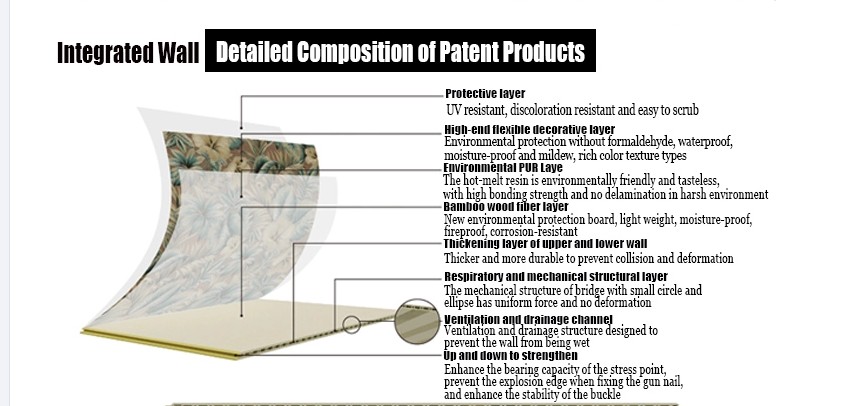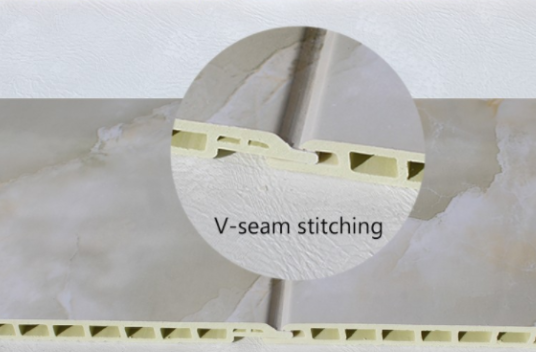Professional Comprehensive Building Materials Supplier
Bamboo Fibre Wall Panel
- Description
Referred to as "the Black Diamond" in Japan and Southeast Asia, bamboo charcoal fiber use is an emerging trend as manufacturers look to combine green living style with function.
The bamboo charcoal is created by heating bamboo at temperatures of 800 degrees and then the charcoal itself is processed and mixed in with fabrics as part of the growing field of nanotechnology.

Characteristic
Bamboo fiber has fine unit fineness and soft feel; good whiteness and bright color; strong toughness and abrasion resistance, with unique resilience; strong longitudinal and transverse strength, and stable and uniform, good drape; soft and smooth Shuang is not tied, softer than cotton, with a unique velvet feel.
The cross-section of bamboo charcoal fiber is covered with large and small oval pores, which can instantly absorb and evaporate a large amount of water. The height of the natural cross-section is hollow, making industry experts call bamboo charcoal fibers "breathable" and "fiber queen." Bamboo charcoal fiber has the highest hygroscopicity, moisture release, and air permeability among the major textile fibers.

1. The variety of colors and patterns
2. High intensity, resist erosion, anti-aging
3. Fireproof, waterproof, environmentally friendly
4. Easy setting and cleaning
5. Flame retardant, non-flammable.
6. It is impenetrable by insects or termites, and won't rot or rust
7. Resistance to weather/ special chemicals; Waterproof / Washable
8. The excellent rigid and superior impacted surface is without any peelingWPC and Bamboo Fibre Panel
Bamboo fiber wall panel is one kind of the Wood-plastic composites (WPCs). They are produced by thoroughly mixing ground wood particles and heated thermoplastic resin. The most common method of production is to extrude the material into the desired shape, though injection molding is also used. WPCs may be produced from either virgin or recycled thermoplastics including HDPE, LDPE, PVC, PP, ABS, PS, and PLA. Polyethylene-based WPCs are by far the most common. Additives such as colorants, coupling agents, UV stabilizers, blowing agents, foaming agents, and lubricants help tailor the end product to the target area of application. Extruded WPCs are formed into both solid and hollow profiles. A large variety of injection molded parts is also produced, from automotive door panels to cell phone covers.
In some manufacturing facilities, the constituents are combined and processed in a pelletizing extruder, which produces pellets of the new material. The pellets are then re-melted and formed into the final shape. Other manufacturers complete the finished part in a single step of mixing and extrusion.
Due to the addition of organic material, WPCs are usually processed at far lower temperatures than traditional plastics during extrusion and injection molding. WPCs tend to process at temperatures of about 50 °F (28 °C) lower than the same, unfilled material, for instance. Most will begin to burn at temperatures around 400 °F (204 °C). Processing WPCs at excessively high temperatures increases the risk of shearing, or burning and discoloration resulting from pushing a material that’s too hot through a gate which is too small, during injection molding. The ratio of wood to plastic in the composite will ultimately determine the melt flow index (MFI) of the WPC, with larger amounts of wood generally leading to a lower MFI.
WPCs do not corrode and are highly resistant to rot, decay, and marine borer attack. WPCs have good workability and can be shaped using conventional woodworking tools. WPCs are often considered a sustainable material because they can be made using recycled plastics and the waste products of the wood industry. One advantage over wood is the ability of the material to be molded to meet almost any desired shape. A WPC member can be bent and fixed to form strong arching curves. Another major selling point of these materials is their lack of need for paint. They are manufactured in a variety of colors but are widely available in grays and earth tones. Despite up to 70 percent cellulose content (although 50/50 is more common), the mechanical behavior of WPCs is most similar to neat polymers. Neat polymers are polymerized without added solvents.
Cross-section of Bamboo Fibre Wall Panel

Installation of Bamboo Fibre Wall Panel
Method1: Directly insert the stainless steel fastener into the bottom of the wallboard and fix it to the blank wall.This method is suitable for the wall with good wall flatness.
Method2: The wall is leveled with a keel,and the stainless steel fasteners are fixed on the wooden keel with self-tapping screw. By this method,the boards can be removed and reused.
Method3: The wall is fixed with wooden keel,and bottom is fixed to the wooden keel directly with the row of nails.This method is convenient and quick.


For further information or cooperation, please feel free to contact us.
Tel: 010-88082306; 010-88082322
E-mail: aliciachn@outlook.com; wudi@cbme.cn
CONTACT US
Tel | 86-010-88082316
Email | aliciachn@outlook.com
BuildTech Corporation
China Building Materials Building, No. 11
Sanlihe Road, Haidian
Message
Please leave us a message, we will be at your service.
BuildTech Corporation © All Rights Reserved





